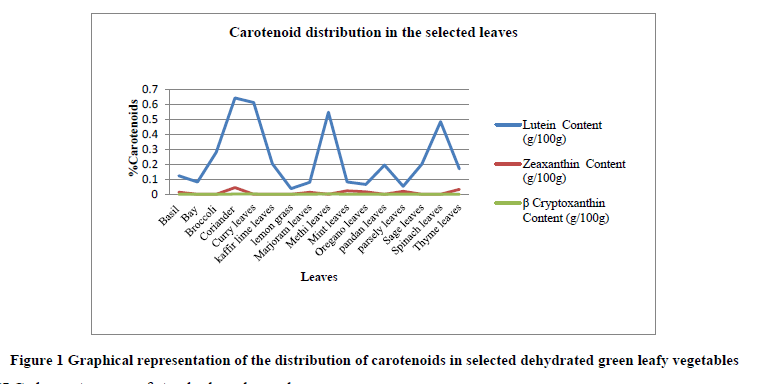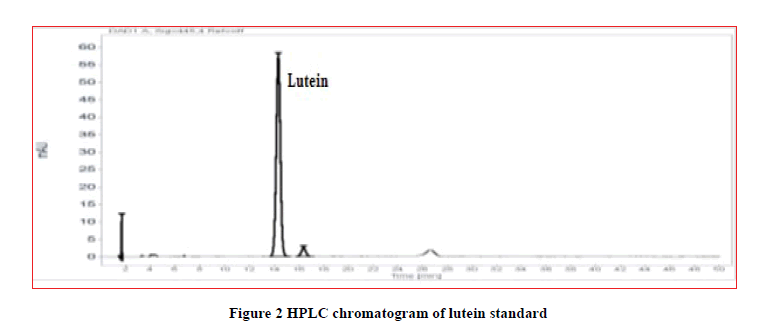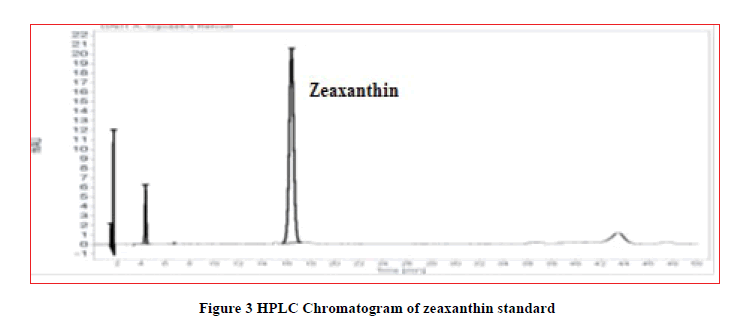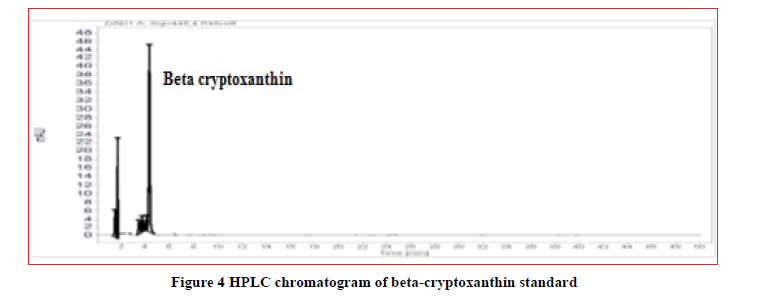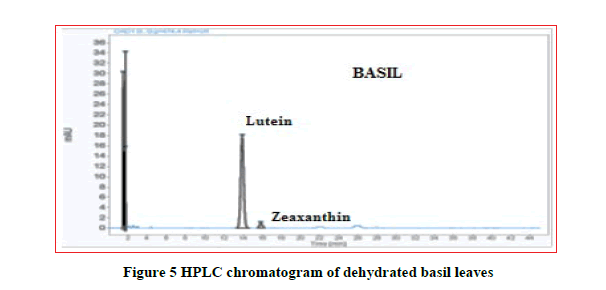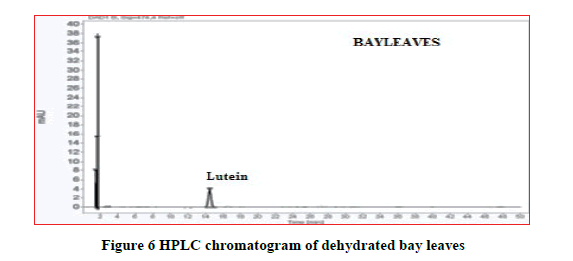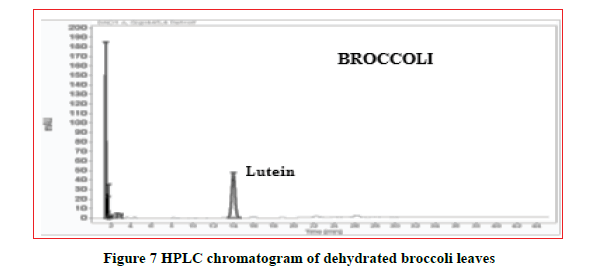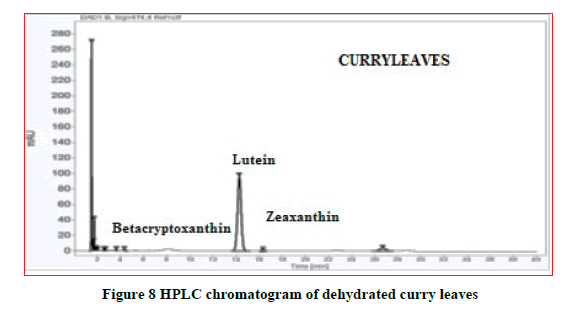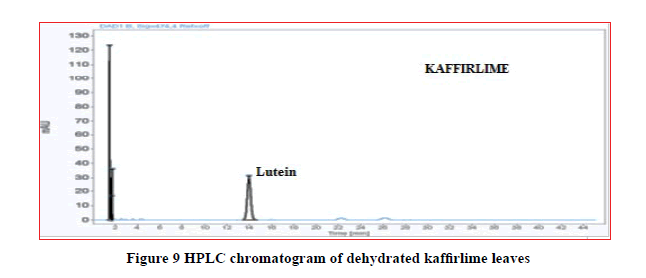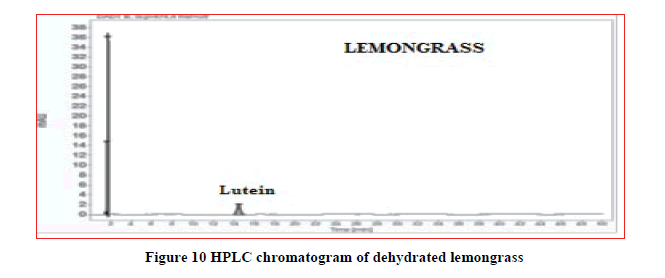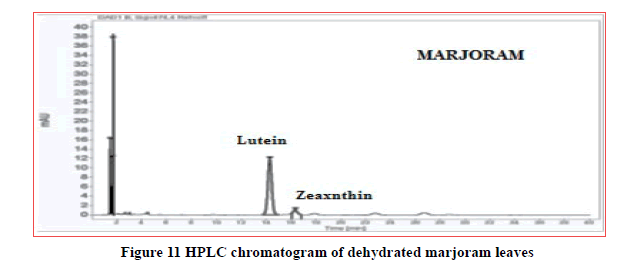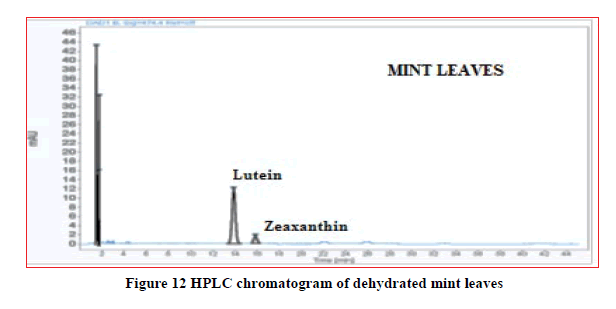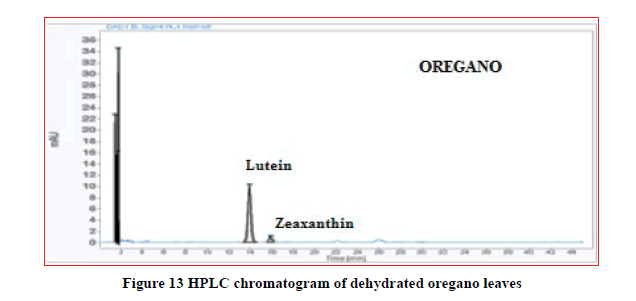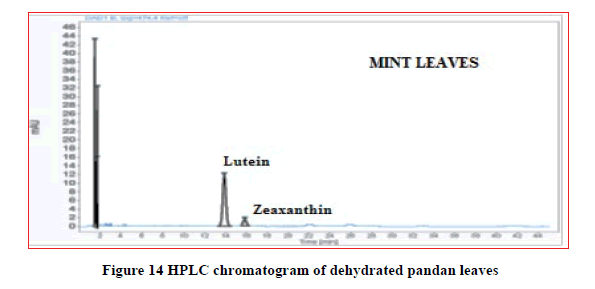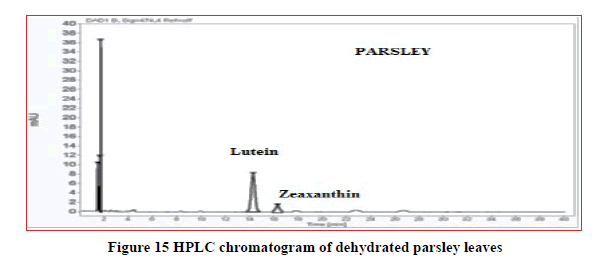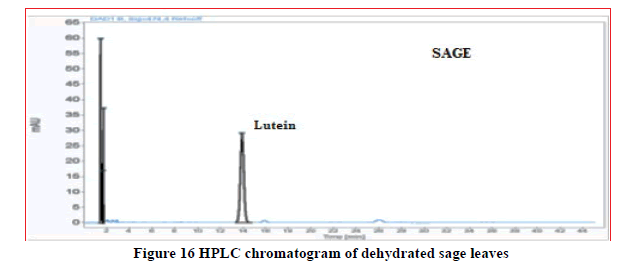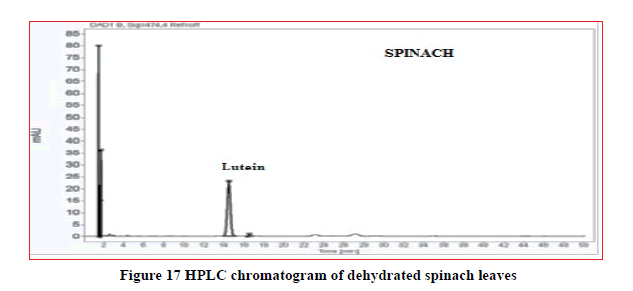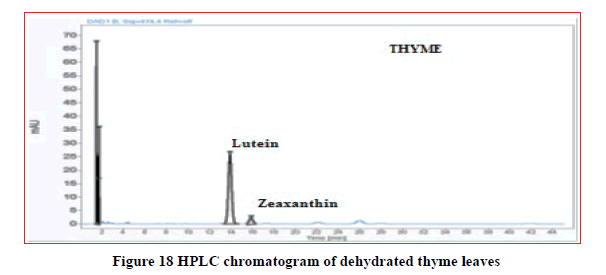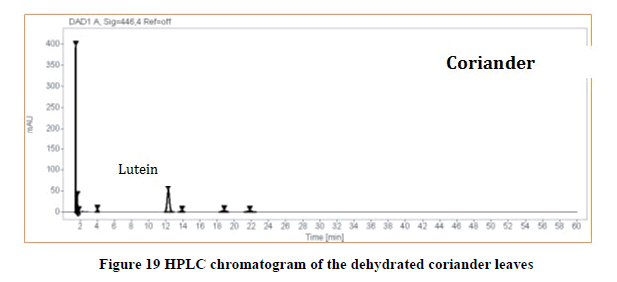Research - International Journal of Medical Research & Health Sciences ( 2020) Volume 9, Issue 12
Screening of Sixteen Commonly Consumed Green Leafy Vegetables for Carotenoids
Anusha A M, Sherena P A, P T Annamala* and J K Mukkadan2Department of Biochemistry, Little Flower Medical Research Centre, Angamaly, Kerala, India
3Department of Biochemistry, Jubilee Mission Medical College, Thrissur, Kerala, India
4Research Director, Little Flower Medical Research Centre, Angamaly, Kerala, India
P T Annamala, Department of Biochemistry, Jubilee Mission Medical College, Thrissur, Kerala, India, Email: drannamala@gmail.com
Received: 25-Nov-2020 Accepted Date: Dec 21, 2020 ; Published: 28-Dec-2020
Abstract
Introduction: Carotenoids can act as an antioxidant, anti-inflammatory, and anticancer agents. Important bioactive carotenoids are present in green leafy vegetables, which form part of dietary ingredients. Objective: The present study is aimed at screening sixteen commonly consumed green leafy vegetables for the distribution of carotenoids. Methods: Sixteen green leafy vegetables-curry leaves (Murraya koenigii), fenugreek (methi) leaves (Trigonella foenum-graecum), coriander leaves (Coriandrum sativum), broccoli leaves (Brassica oleracea), bay leaves (Laurus nobilis), oregano leaves (Origanum vulgare), marjoram leaves (Origanum majorana), basil leaves (Ocimum basilicum), pandan leaves (Pandanus amaryllifolius), sage leaves (Salvia officinalis), thyme leaves (Thymus vulgaris), lemon grass (Cymbopogon citratus), kaffirlime leaves (Citrus hystrix) and parsley leaves (Petroselinum crispum) were dehydrated, and carotenoids were extracted and analysed by HPLC. Results: Of the leaves analyzed, curry leaves, coriander leaves, and fenugreek leaves were found to be rich sources of carotenoids. Conclusion: These findings suggest that curry leaves, coriander leaves, and fenugreek leaves are rich in carotenoids and can be used for the preparation of carotenoid-rich extracts for studying antioxidant, anti-inflammatory, and anticancer activities.
Keywords
Green leafy vegetables, Carotenoids, HPLC
Introduction
Plant extracts can provide unlimited opportunities for new drug discoveries because of their abundant availability and chemical diversity [1]. The use of herbal medicines in Asia has a long history of human interactions with the environment. Plants used for traditional medicine contain a wide range of substances that can be used to treat chronic and infectious diseases [2]. According to the World Health Organization (WHO), nearly 20,000 medicinal plants exist in 91 countries, including 12 mega biodiversity countries [3]. Carotenoids are one of the major bioactive compounds present in edible vegetables.
Carotenoids are lipid-soluble C40 tetraterpenoids derived from 40 carbon polyene chain. This chain may be ceased by adding cyclic end-groups and may be complemented with oxygen-containing functional groups [4]. Carotenoids form important classes of plant pigments and play a crucial role in defining the quality parameters of fruits and vegetables [5]. High concentrations of carotenoids are found in fruits and vegetables and are widely believed to provide many health benefits [6]. The bioavailability of carotenoids from plant food is dependent on the food matrix, processing and cooking, structure of carotenoid present, the amount consumed, and absorption in the intestinal tract [7]. Carotenoids are normal constituents in human blood and tissues such as adipose, liver, muscles, and retina. These pigments are taken into the human body through the dietary intake of fruits and vegetables. Epidemiological studies show that a high intake of fruits and vegetables has a protective effect against cancer and other chronic diseases [8]. The distribution, quantification, and characterization of carotenoids are essential for better interpreting epidemiologic studies concerning diet.
Carotenoids can scavenge or deactivate free radicals through their singlet oxygen quenching or free radical scavenging activity and thereby acting as antioxidants in the human body. Depending on the redox potential and biological environment, carotenoids shift from antioxidants to pro-oxidants [9]. Carotenoids can block or impede tumour promotion and progression by modulating key signalling pathways induced by tumour promoters, inflammatory cytokines, and growth factors [10]. Carotenoids are part of a vast spectrum of natural pigments and have been found to lessen the risk of many chronic diseases such as cancer, heart disease, and certain eye diseases [11]. Carotenoid-rich dietary constituents such as fruits and vegetables have been associated with a decreased risk of lung, stomach, and prostate cancers [12]. Lutein and zeaxanthin are the antioxidant carotenoids found in many fruits, vegetables, and flowers, as well as in dark leafy vegetables [13].
Plants/plant extracts/decoctions used by ancient ayurvedic for treating several diseases represent a source of chemical entities, but not much information is available on their nature. Taking this viewpoint into consideration, the present study aims to screen commonly consumed green leafy vegetables for the distribution of carotenoids, which is reported to have beneficial effects on human health. This research is taken up to study the distribution of carotenoids such as lutein, zeaxanthin, and cryptoxanthin present in sixteen different leafy vegetables by HPLC technique.
Materials and Methods
Materials
Dehydrated green leafy vegetables-curry leaves (Murraya koenigii), fenugreek (methi) leaves (Trigonella foenumgraecum), coriander leaves (Coriandrum sativum), broccoli leaves (Brassica oleracea), bay leaves (Laurus nobilis), oregano leaves (Origanum vulgare), marjoram leaves (Origanum majorana), basil leaves (Ocimum basilicum), pandan leaves (Pandanus amaryllifolius), sage leaves (Salvia officinalis), thyme leaves (Thymus vulgaris), lemongrass (Cymbopogon citratus), kaffirlime leaves (Citrus hystrix) and parsley leaves (Petroselinum crispum) were collected from different regions.
Solvents methanol, ethyl alcohol, acetone, hexane, ethyl acetate, and toluene were purchased from Merck. Reagents Folin and Ciocalteu, sodium nitrite, aluminium chloride, potassium hydroxide, sodium carbonate, and sodium sulfate were also purchased from Merck. Carotenoid standards such as lutein, zeaxanthin, β-carotene, and β-cryptoxanthin were received from Omni Active Health Technologies, Mumbai.
Methods
Extraction of carotenoids from dried leaves: A representative sample of the grinded leafy sample 3 g was refluxed with 10 ml hexane, 6 ml ethanol, 6 ml acetone, 7 ml toluene, and 2 ml of 40% methanolic potassium hydroxide in a water bath kept at 56°C ± 0.5°C for 20 min. The sample was cooled, and 30 ml hexane was added and diluted to the mark with 10% sodium sulphate solution and allowed to stand in the dark for 1 hour for phase separation to take place. 1 ml of aliquot was pipetted from the upper phase into a 50 ml volumetric flask and diluted to the mark with the solvent hexane: acetone: methanol (8:1:1). 5 ml of the aliquot was taken from the upper phase and was filtered using a 0.22-micron millipore filter, and 20 μl of the solution was injected into the HPLC column. Individual standards of carotenoids were also prepared by dissolving the respective standards in ethyl acetate (50-100 ppm concentration). The values obtained are expressed as mean ± Standard Deviation (SD).
Results
Lutein content in coriander leaves, curry leaves, and fenugreek leaves are in the range of (0.55 ± 0.02)%-(0.64 ± 0.07)%, while in broccoli, kaffirlime, spinach, sage are in the range of (0.20 ± 0.027)%-(0.48 ± 0.13)% and others like basil, bay leaves, lemongrass, marjoram, mint, oregano, parsley, and thyme are (0.03 ± 0.01)%-(0.19 ± 0.09)%. Zeaxanthin content in basil, coriander, marjoram, mint, oregano, parsley, and thyme are in the range of (0.014 ± 0.003)%-(0.045 ± 0.004)%, and in others, no zeaxanthin was detected. In most of the dried leaves, beta-cryptoxanthin was not showing any peak, but coriander, curry leaves, and fenugreek show (0.00115 ± 0.00014)%, (0.00015 ± 0.00018)%, and (0.0026 ± 0.00034)%, respectively (Table 1).
| No: | Sample name | Lutein content (g/100g) | Zeaxanthin content (g/100g) | β-Cryptoxanthin content (g/100g) |
|---|---|---|---|---|
| 1 | Basil leaves | 0.12 ± 0.001 | 0.014 ± 0.0007 | 0 |
| 2 | Bay leaves | 0.08 ± 0.03 | 0 | 0 |
| 3 | Broccoli leaves | 0.28 ± 0.08 | 0 | 0 |
| 4 | Coriander leaves | 0.64 ± 0.07 | 0.045 ± 0.005 | 0.0011 ± 0.0001 |
| 5 | Curry leaves | 0.61 ± 0.09 | 0 | 0.0012 ± 0.0002 |
| 6 | Kaffir lime leaves | 0.20 ± 0.06 | 0 | 0 |
| 7 | Lemon grass | 0.04 ± 0.01 | 0 | 0 |
| 8 | Marjoram leaves | 0.08 ± 0.02 | 0.013 ± 0.003 | 0 |
| 9 | Fenugreek leaves | 0.55 ± 0.07 | 0 | 0.0026 ± 0.0003 |
| 10 | Mint leaves | 0.08 ± 0.05 | 0.023 ± 0.014 | 0 |
| 11 | Oregano leaves | 0.07 ± 0.04 | 0.016 ± 0.009 | 0 |
| 12 | Pandan leaves | 0.19 ± 0.09 | 0 | 0 |
| 13 | Parsley leaves | 0.05 ± 0.02 | 0.020 ± 0.007 | 0 |
| 14 | Sage leaves | 0.20 ± 0.03 | 0 | 0 |
| 15 | Spinach leaves | 0.48 ± 0.01 | 0 | 0 |
| 16 | Thyme leaves | 0.17 ± 0.06 | 0.033 ± 0.01 | 0 |
Table 1 Carotenoids (lutein, zeaxanthin and β-cryptoxanthin) content (g/100g) in dehydrated leafy vegetables (values are expressed as mean ± SD)
No. of analysis conducted: 3
The method adopted for analysis: HPLC
The distribution of carotenoids in the sixteen green leafy vegetables selected for the study is presented in Figure 1.
HPLC chromatograms of standards and samples
HPLC chromatograms of carotenoid standards are presented-lutein (Figure 2), zeaxanthin (Figure 3), and cryptoxanthin (Figure 4).
HPLC chromatogram of carotenoid extracts are presented-basil leaves (Figure 5), bay leaves (Figure 6), Broccoli leaves (Figure 7), curry leaves (Figure 8), kaffirlime leaves (Figure 9), Lemongrass leaves (Figure 10), marjoram leaves (Figure 11), mint leaves (Figure 12), oregano leaves (Figure 13), pandan leaves (Figure 14), parsley leaves (Figure 15), sage leaves (Figure 16), spinach leaves (Figure 17), Thyme leaves (Figure 18), coriander leaves (Figure 19) and fenugreek leaves (Figure 20).
Discussion
The phytochemical constituents present in green leafy vegetables are of great importance. Their consumption improves human health. Green leafy vegetables are identified to contain natural antioxidants such as polyphenols, flavonoids, vitamins, and carotenoids. The carotenoids such as lutein and zeaxanthin present in green leafy vegetables have been proved to have antioxidant, anti-inflammatory, and anticancer activities. Many edible fruits and vegetables are relatively good sources of carotenoids. The method described above permits the determination of the distribution of carotenoids in frequently consumed vegetables in different world regions. The distribution of carotenoids using highperformance liquid chromatography is focused on the quantification of oxycarotenoids such as lutein, zeaxanthin, and beta-cryptoxanthin. We can infer from the results from the carotenoids present in leaves, almost 50% will be the oxycarotenoid lutein, and 5% will be the zeaxanthin.
Carotenoids are synthesized by several plant species, certain algae, and some bacteria, and once synthesized, different carotenoids exhibit different benefits. For example, several studies reported that β-carotene foods have anti-inflammatory and cancer-protective effects; β-cryptoxanthin also has anticancer activity [14], while lutein and zeaxanthin are the only two carotenoids found in the retina, so they are more accompanied with age-related eye diseases and improves the vision [15].
Conclusion
Bioactive compounds occurring in plant material consisting of multi-component mixtures, their separation, and determination is cumbersome. The distribution of carotenoids lutein, zeaxanthin, and cryptoxanthin from 16 different leafy vegetables was analyzed by high-performance liquid chromatography. The chromatograms are compared with pure standards of lutein, zeaxanthin, and cryptoxanthin. We could ascertain that curry leaves, coriander leaves, and fenugreek leaves are the richest sources among the 16 leafy vegetables screened, and hence these three can be selected for the isolation carotenoid-rich extracts.
Declarations
Acknowledgment
The authors acknowledge the support of Little Flower Medical Research Centre, Kerala, and Care Keralam Ltd. Kerala, India.
Conflict of Interest
The authors declared no potential conflicts of interest with respect to the research, authorship, and/or publication of this article.
References
- Cos, Paul, et al. "Anti-infective potential of natural products: how to develop a stronger in vitro ‘proof-of-concept’." Journal of Ethnopharmacology, Vol. 106, No. 3, 2006, pp. 290-302.
- Duraipandiyan, Veeramuthu, Muniappan Ayyanar, and Savarimuthu Ignacimuthu. "Antimicrobial activity of some ethnomedicinal plants used by Paliyar tribe from Tamil Nadu, India." BMC Complementary and Alternative Medicine, Vol. 6, No. 1, 2006, pp. 35.
- Sasidharan, S., et al. "Extraction, isolation and characterization of bioactive compounds from plants’ extracts." African Journal of Traditional, Complementary and Alternative Medicines, Vol. 8, No. 1, 2011, pp. 1-10.
- Fraser, Paul D., and Peter M. Bramley. "The biosynthesis and nutritional uses of carotenoids." Progress in Lipid Research, Vol. 43, No. 3, 2004, pp. 228-65.
- Van den Berg, H., et al. "The potential for the improvement of carotenoid levels in foods and the likely systemic effects." Journal of the Science of Food and Agriculture, Vol. 80, No. 7, 2000, pp. 880-912.
- Rodriguez-Amaya, Delia B. "Quantitative analysis, in vitro assessment of bioavailability and antioxidant activity of food carotenoids—A review." Journal of Food Composition and Analysis, Vol. 23, No. 7, 2010, pp. 726-40.
- Watson, S. A. "Description, development, structure and composition of the corn kernel." Corn: Chemistry and Technology, 2 ed, 2003, pp. 69-106.
- Block, Gladys, Blossom Patterson, and Amy Subar. "Fruit, vegetables, and cancer prevention: a review of the epidemiological evidence." Nutrition and Cancer, Vol. 18, No. 1, 1992, pp. 1-29.
- Young, Andrew J., and Gordon M. Lowe. "Antioxidant and prooxidant properties of carotenoids." Archives of Biochemistry and Biophysics, Vol. 385, No. 1, 2001, pp. 20-7.
- Trejo-Solís, Cristina, et al. "Multiple molecular and cellular mechanisms of action of lycopene in cancer inhibition." Evidence-based Complementary and Alternative Medicine, Vol. 2013, 2013.
- Johnson, Elizabeth J. "The role of carotenoids in human health." Nutrition in Clinical Care, Vol. 5, No. 2, 2002, pp. 56-65.
- Flagg, Elaine W., Ralph J. Coates, and Raymond S. Greenberg. "Epidemiologic studies of antioxidants and cancer in humans." Journal of the American College of Nutrition, Vol. 14, No. 5, 1995, pp. 419-27.
- Sherena, P. A., et al. "Biochemical assays of crude and purified oxycarotenoid extracts isolated from coriander leaves and their effect on oxidative stability of oils by Rancimat assay." Research & Reviews: A Journal of Biotechnology, Vol. 8, No. 1, 2018, pp. 1-10.
- Ruano-Ravina, A., et al. "Antioxidant vitamins and risk of lung cancer." Current Pharmaceutical Design, Vol. 12, No. 5, 2006, pp. 599-613.
- Landrum, John T., and Richard A. Bone. "Lutein, zeaxanthin, and the macular pigment." Archives of Biochemistry and Biophysics, Vol. 385, No. 1, 2001, pp. 28-40.

